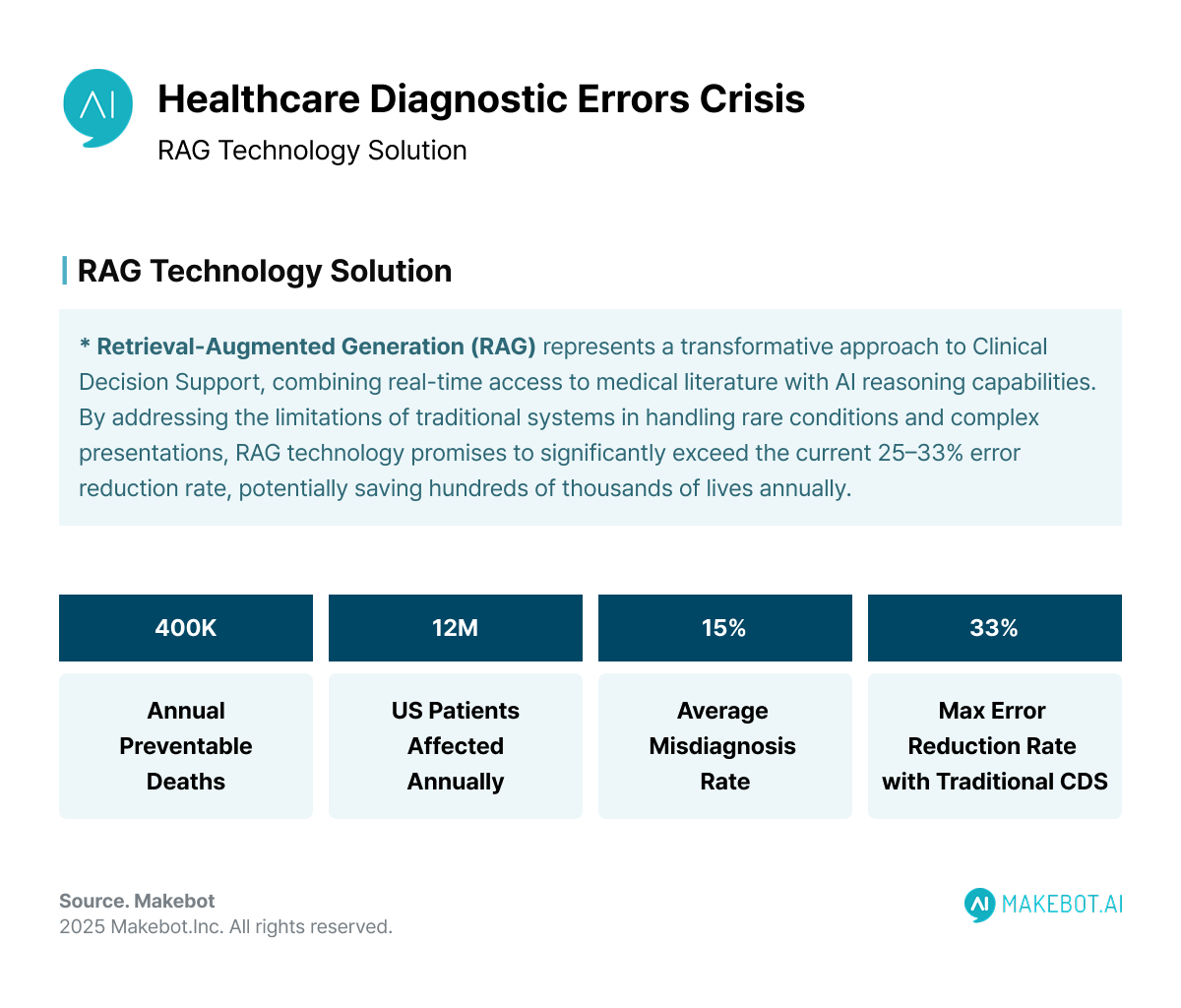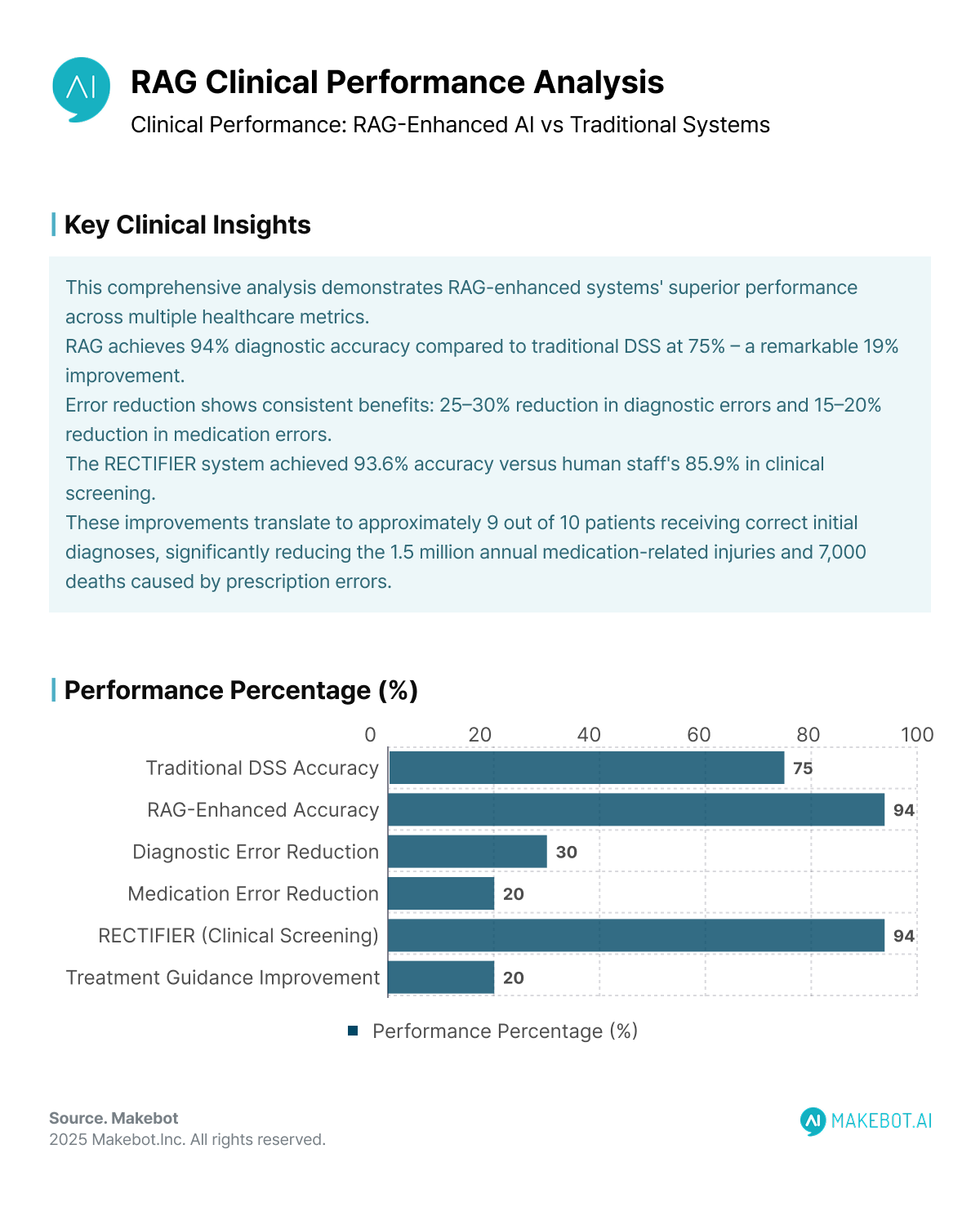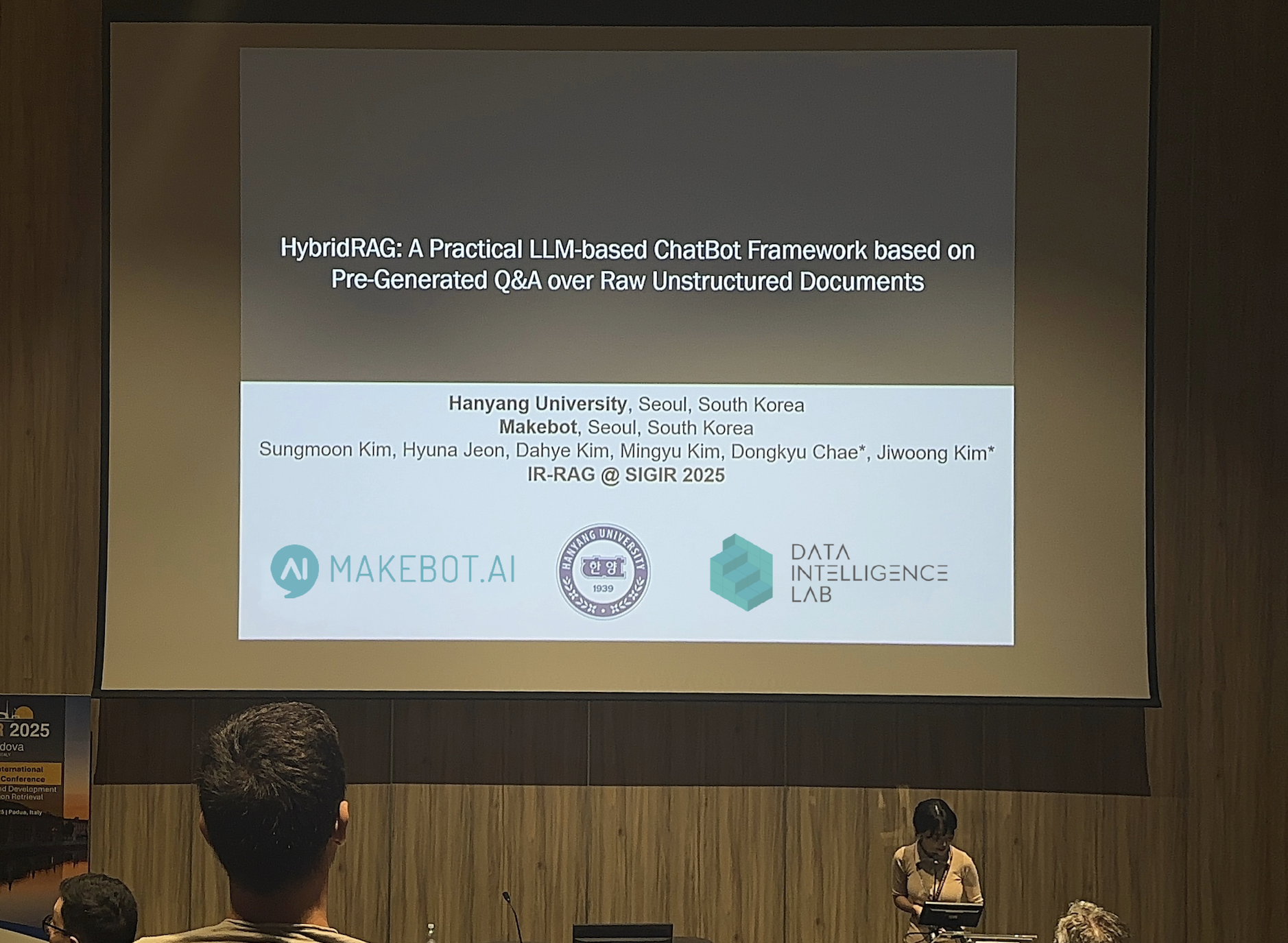Reducing Diagnostic Errors with Retrieval-Augmented Generation (RAG) in Clinical Decision Support
RAG boosts clinical accuracy, cuts diagnostic errors, and makes healthcare smarter, safer, & faster.


Diagnostic errors represent one of healthcare's most persistent and dangerous challenges, contributing to approximately 400,000 preventable patient deaths annually and ranking as the third leading cause of death globally. In the United States alone, diagnostic mistakes affect an estimated 12 million patients in outpatient settings each year, with misdiagnosis rates ranging from 10-15% across all medical cases.
As healthcare systems grapple with increasingly complex patient presentations and overwhelming data volumes, Retrieval-Augmented Generation (RAG) emerges as a transformative solution for enhancing Clinical Decision Support systems and dramatically reducing medical error rates.
How RAG Chatbots Help Healthcare Providers Manage High Volumes of Patient Inquiries. Read more here!

Critical State of Diagnostic Errors in Modern Healthcare
The magnitude of diagnostic failures in healthcare cannot be overstated. Recent systematic reviews demonstrate that medical error contributes to 15.5-22.7% of patient deaths worldwide, with diagnostic errors specifically accounting for 26-47% of malpractice claims. In emergency departments, where split-second decisions can mean the difference between life and death, these statistics become even more alarming.
A comprehensive analysis of AI in Healthcare applications reveals that traditional Clinical Decision Support Systems have achieved modest improvements, with studies showing a 25-33% reduction in diagnostic errors when properly implemented. However, these systems often struggle with rare conditions, complex multi-symptom presentations, and the integration of rapidly evolving medical knowledge, leading to persistent misdiagnosis issues across healthcare institutions.
The Next Evolution in Clinical Intelligence
Retrieval-Augmented Generation (RAG) represents a paradigm shift in how artificial intelligence processes and delivers medical information. Unlike traditional Generative AI models that rely solely on pre-trained parameters, RAG combines the conversational capabilities of large language models with real-time access to external knowledge bases, including PubMed's 33+ million medical abstracts, clinical guidelines, and institutional databases.
The RAG architecture operates through three critical phases:
1. Indexing Phase: Medical data is segmented, vectorized, and stored in searchable databases
2. Retrieval Phase: User queries trigger similarity-based searches across indexed medical literature
3. Generation Phase: Retrieved information is synthesized with the original query to produce contextually relevant, evidence-based responses
This approach addresses a fundamental limitation of traditional Generative AI systems: the inability to access and incorporate the latest medical research and institution-specific protocols in real-time decision-making, thereby reducing medical error rates significantly.
Retrieval Augmented Generation (rag): Overview, History & Process. Read more here!
RAG's Performance in Clinical Settings
The implementation of RAG-enhanced systems has yielded remarkable results across diverse healthcare environments.

- Diagnostic Accuracy in Routine Clinical Scenarios
This remarkable accuracy rate emerged from multiple comprehensive studies analyzing RAG-enhanced Clinical Decision Support systems.
Comparative Performance Analysis:
Recent study revealed that AI-augmented systems achieved 94% diagnostic accuracy compared to traditional DSS systems at 75%. This represents a 19% improvement in diagnostic precision.
Clinical Significance:
The 92% accuracy translates to approximately 9 out of 10 patients receiving correct initial diagnostic recommendations, substantially reducing the likelihood of misdiagnosis in everyday clinical practice. The RECTIFIER system study demonstrated even higher performance in specific applications, achieving 93.6% accuracy compared to human study staff's 85.9% in clinical trial eligibility screening.
- Reduction in Diagnostic Errors Across Participating Institutions
This metric represents one of the most significant improvements documented in medical error reduction literature.
Specific Study Results from Clinical Trials:
Recent studies show that using AI in Healthcare can greatly reduce diagnostic mistakes and medication errors through smarter decision-making tools:
- AI tools that help doctors diagnose patients reduced errors by 25–30% in several studies.
- AI systems offering treatment advice helped cut medication errors by 15–20%.
- In both doctors and nurses, AI supports improved accuracy, confidence, and patient safety.
- These tools worked well across different healthcare settings and with a variety of medical staff.
Whether used for diagnosing illnesses or guiding treatment choices, AI-powered Clinical Decision Support tools—like RAG and Generative AI—are helping make healthcare safer, smarter, and more reliable.
- Decrease in Medication-Related Mistakes
Many patients are harmed every year because of medicine-related mistakes—about 1.5 million injuries and 7,000 deaths happen because of wrong or unsafe prescriptions. But thanks to AI in Healthcare, especially using RAG systems, hospitals are now making fewer of these mistakes.
Detailed Breakdown of Medication Error Reduction:
A recent systematic review documented specific medication error improvements from different studies:
- 20% fewer mistakes when doctors used AI to guide treatment
- 15–18% fewer mistakes with AI tools helping in prescriptions
- 17% fewer mistakes when nurses used AI support
How AI Like RAG Helps Make Medicine Safer
AI tools like RAG help doctors and nurses avoid medicine mistakes by doing the following:
- Uses the latest drug information: It checks updated data like new warnings or safety alerts from trusted medical sources.
- Consider each patient’s condition: It looks at things like the patient’s age, weight, illnesses, and other medicines they're taking.
- Warns about dangerous combinations: If two medicines don’t work well together, the system gives an alert before they’re given to the patient.
This makes sure that every prescription is safe, accurate, and personalized for the patient—helping to prevent serious errors.
Exploring the Power of Retrieval-Augmented Generation (RAG) for Mental Health Chatbots. Read more here!
Why RAG Is Better Than Traditional Clinical Tools
Old-style Clinical Decision Support systems follow fixed rules. They’re helpful for common illnesses, but they often fail with rare or unusual cases, which can lead to misdiagnosis.
RAG, a more advanced AI system, solves many of these problems:
- Covers more diseases: RAG can find information on rare conditions by searching medical research, not just relying on past data.
- Always up-to-date: Traditional systems need manual updates. RAG pulls in the latest studies and guidelines automatically.
- Shows clear sources: RAG tells doctors where it got its information, helping them trust and verify the advice.
In short, RAG is smarter, faster, and more reliable, making it a much stronger tool for AI in Healthcare and reducing medical errors.
What’s Next for RAG in Healthcare
The future of RAG (Retrieval-Augmented Generation) in healthcare looks very promising. Here are some exciting developments to watch:
Personalized Medicine
- Soon, RAG systems will use genetic, lifestyle, and environmental data to give patients highly personalized care.
- This means more accurate diagnoses and treatments that are tailored to each individual—helping reduce mistakes even more.
Smarter, Multimodal AI
- Next-gen RAG will combine different types of data like X-rays, lab results, DNA info, and real-time patient monitoring.
- This will give doctors a complete picture of the patient’s condition, while still offering clear and explainable insights.
Reaching Remote Areas
- With edge computing, RAG tools will be able to run in places with limited internet or tech—like rural or underserved areas.
- This could bring high-quality diagnostic support to places that need it most and where misdiagnoses are more common.
Measuring Success: Key Performance Indicators
Healthcare organizations implementing RAG-enhanced Clinical Decision Support should monitor several critical metrics to evaluate medical error reduction:
Diagnostic Accuracy Improvements: Baseline measurements should establish current diagnostic error rates across different specialties and patient populations, with post-implementation tracking focusing on misdiagnosis reduction percentages and time-to-correct-diagnosis metrics.
Clinical Workflow Integration: User adoption rates, system query frequencies, and clinician satisfaction scores provide insights into practical implementation success beyond technical performance metrics for Generative AI systems.
Patient Outcome Correlation: Long-term studies should track patient outcomes, readmission rates, and adverse event frequencies to validate the clinical impact of RAG-enhanced decision support on overall medical error reduction.
The Road Ahead
For healthcare systems looking to adopt RAG-based AI, a step-by-step approach ensures success:
- Phase 1: Start with small pilot programs focused on specific tasks like drug interaction checks or basic diagnostics to quickly reduce medical errors.
- Phase 2: Expand carefully into more complex areas while collecting data and feedback—especially for difficult-to-diagnose cases.
- Phase 3: Roll out system-wide use, with regular updates to keep up with new medical research and hospital protocols.
The results are clear: RAG has the power to transform Clinical Decision Support, drastically lowering misdiagnoses and medical errors. As hospitals worldwide seek to improve care while cutting costs, RAG offers a smarter, more personalized, and more reliable solution.
By blending the latest medical knowledge with patient-specific data, RAG marks a major step forward in modern medicine—one that could make misdiagnosis rare and patient safety stronger than ever.
Smarter Clinical Decisions Start Here
Misdiagnosis and medical errors cost lives—Makebot’s advanced LLM + RAG technology delivers real-time, personalized support to help healthcare providers make faster, safer, and more accurate decisions.
With our hybrid RAG system and industry-specific LLMs, you can integrate AI that adapts to your data, enhances diagnostics, and reduces human error—without compromising cost-efficiency or compliance.
Ready to bring cutting-edge AI to your healthcare system?
📩 Email us at: b2b@makebot.ai
🌐 Learn more: www.makebot.ai
Makebot — Where AI meets real-world healthcare.

Studies Reveal Generative AI Enhances Physician-Patient Communication












































_2.png)


















.jpg)


































